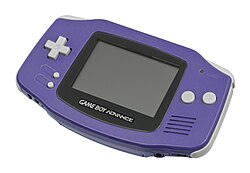Game Boy Advance

The indigo version of the Game Boy Advance.
|
|
| Manufacturer | Nintendo |
|---|---|
| Product family | Game Boy line |
| Type | Handheld game console |
| Generation | Sixth generation |
| Release date | |
| Retail availability | 2001-2010 |
| Discontinued | May 15, 2010 |
| Units sold | 81.51 million (as of June 30, 2010[update]) |
| Media | ROM cartridge |
| CPU | ARM7TDMI @ 16.78 MHz, Zilog Z80 @ 8 or 4 MHz |
| Memory | 32 KB internal, 256 KB external, 96 KB VRAM |
| Display | TFT LCD, 240 × 160 pixels |
| Power | 2 × AA batteries |
| Best-selling game | Pokémon Ruby and Sapphire, 16 million combined |
| Backward compatibility |
Game Boy, Game Boy Color |
| Predecessor | Game Boy Color |
| Successor | Nintendo DS |
The Game Boy Advance (Japanese: ゲームボーイアドバンス Hepburn: Gēmu Bōi Adobansu?) (abbreviated as GBA) is a 32-bit handheld video game console developed, manufactured and marketed by Nintendo as the successor to the Game Boy Color. It was released in Japan on March 21, 2001, in North America on June 11, 2001, in Australia and Europe on June 22, 2001, and in the People's Republic of China on June 8, 2004 (excluding Hong Kong). Nintendo's competitors in the handheld market at the time were the Neo Geo Pocket Color, WonderSwan, GP32, Tapwave Zodiac, and the N-Gage. Despite the competitors' best efforts, Nintendo maintained a majority market share with the Game Boy Advance.
As of June 30, 2010, the Game Boy Advance series has sold 81.51 million units worldwide. Its successor, the Nintendo DS, was released in November 2004 and is also compatible with Game Boy Advance software.
Contrary to the previous Game Boy models, which were all following the "portrait" form factor of the original Game Boy (designed by Gunpei Yokoi), the Game Boy Advance was designed in a "landscape" form factor, putting the buttons to the sides of the device instead of below the screen. The Game Boy Advance was designed by the French designer Gwénaël Nicolas and his Tokyo-based design studio Curiosity Inc.
In 1996, magazines including Electronic Gaming Monthly, issues 53 and 54 of Total! and the July 1996 issue of Game Informer featured reports of a new Game Boy, codenamed Project Atlantis. Although the expected release date of "early 1997" would make that machine seem to be the Game Boy Color, it was described as having a 32-bit RISC processor, a 3-by-2-inch color LCD screen, and a link port—a description that more closely matches the Game Boy Advance. It also may have referred to the unnamed, unreleased Game Boy Color successor prototype that was revealed at 2009's Game Developers Conference. It was announced that Nintendo Co., Ltd. (NCL) was working on a game for the system called "Mario's Castle".
...
Wikipedia
